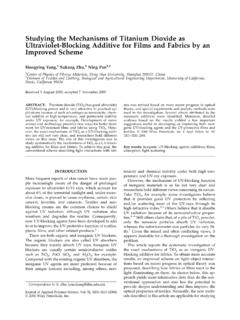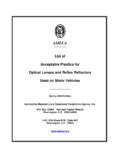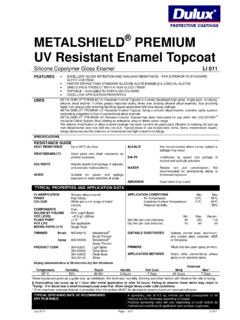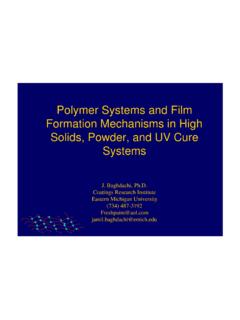Transcription of UV CIPP Specification - Cured In Place Pipe (CIPP) Lining ...
1 Richard Montemarano [Pick the date] UV CIPP Specification Designed for municipal engineers and project managers for the inclusion of all ultra violet light Cured fiberglass Lining products within a CIPP Specification LightStream, December 17, 2009 2 UV CIPP Specification Project The Contractor shall rehabilitate the structurally and/or functionally deteriorated sanitary sewer and/or storm water pipelines using the trenchless method of Cured -in- Place pipe (CIPP) by ultraviolet light cure in accordance with these Specifications. The CIPP material shall consist of a resin-impregnated fiberglass material tube ( Liner ) which when Cured shall extend the full length of the original pipe and provide a structurally sound, smooth, jointless and watertight pipe. Reference Specifications, Codes, and Standards The following documents form a part of this Specification to the extent stated herein.
2 ASTM F2019 Standard Practice for Rehabilitation of Existing Pipelines and Conduits by the Pulled in Place Installation of Glass Reinforced Plastic (GRP) Cured -in- Place Resin Pipe (CIPP) ASTM F1216 Standard Practice for Rehabilitation of Existing Pipelines and Conduits by the Inversion and Curing of a Resin-Impregnated Tube. ASTM F1743 Standard Practice for Rehabilitation of Existing Pipelines and Conduits by the Pull in and inflate and Curing of a Resin-Impregnated Tube. ASTM D543 Test Method for Resistance of Plastics to Chemical Reagents ASTM D578 Standard Specification Glass Fiber Strands ASTM D638 Standard Test Method for Tensile Properties of Plastics. ASTM D790 Standard Test Methods for Flexural Properties of Unreinforced and Reinforced Plastics and Electrical Insulating Materials. ASTM D2122 Standard 1 Test Method for Determining Dimensions of Thermoplastic Pipe and Fittings ASTM D3567 Standard Practice for Determining Dimensions of Fiberglass (Glass-Fiber-Reinforced Thermosetting Resin) Pipe and Fittings ASTM D5813 Standard Specification for Cured -in Place Thermosetting Resin Sewer Pipe Contractor Qualifications The Contractor shall demonstrate that a minimum of 50,000 ft, has been successfully performed by the Contractor s job Superintendent, who shall be assigned full time to this Project.
3 The proposed CIPP Rehabilitation process shall be proven technology, which is defined as a minimum of 100,000 linear feet of successful sanitary sewer and/or storm water collection system installations in the , documented to the satisfaction of the Owner. LightStream, December 17, 2009 3 UV CIPP Specification Contractor Submittals A. The Contractor shall submit, prior to the installation or use of any Lining materials or equipment, certified test results from the manufacturers which indicate that all materials conform to the applicable requirements. B. Chemical resistance submittals --- The Contractor shall submit test results of the resin proposed that meet the chemical resistance requirements of ASTM F2019, Section The chemical resistance tests will be completed in accordance with Test Method D543. C. CIPP Field Samples ---Field sampling procedure shall be in accordance with ASTM 2019 and in accordance with ASTM D5813.
4 D. MSDS Sheets --- The Contractor shall submit Material Safety Data Sheets for all resins, and other additives such as accelerants, colorants, and lubricants utilized in the pipe liner/ Lining process. E. Manufacturer Protocols - The Contractor shall submit manufacturer information that describes the materials, curing speeds, curing installation processes, installation pressures, temperature limitations, and recommended post curing documentation. F. Residential Informational Handout - The Contractor shall submit an informational hand out that describes the materials, processes, installation, pressures, temperature limitations, and odors associated with the Lining process that shall be provided at the request of concerned residents. Materials Neither the CIPP product, nor its installation, shall cause adverse effects to any of the City processes or facilities.
5 The use of the product shall not result in the formation or production of any detrimental compounds or by-products at the wastewater treatment plant. The Contractor shall notify the City and identify any by products produced as a result of the operations, shall test and monitor the levels, and shall comply with any and all local waste discharge requirements. Product Storage and Handling All materials shall be accompanied by test reports certifying that the material conforms to the ASTM standards listed herein. Materials shall be shipped, stored, and handled in a manner consistent with written recommendations of the manufacturer. All damaged materials rejected by the Engineer shall be promptly removed from the project site at the Contractor s expense and disposed of in accordance with current applicable regulations. Liner The fiberglass within the Liner shall be non corrosion (E-CR Glass) material and shall be free from tears, holes, cuts, foreign materials and other surface defects.
6 Its glass fibers must extend in a longitudinal direction to insure no longitudinal stretching during the pull-in process. LightStream, December 17, 2009 4 UV CIPP Specification 1. The Liner shall be constructed to withstand installation pressures as required by Manufacturer s recommendations. 2. The Liner shall be manufactured to a size that when installed will tightly fit the internal circumference and the length of the original pipe. The tube be able to stretch to fit irregular pipe sections and negotiate bends of up to 20 degrees and shall have sufficient strength to bridge missing pipe sections, with the use of a canvas sleeve if necessary. 3. Interior and exterior plastics shall be styrene resistant to protect and contain the resin used in the Liner. 4. The exterior plastic shall be ultra violet light resistant and translucent to allow visual inspection of the impregnation of the resin within the glass fibers.
7 5. The wall color of the interior pipe surface of CIPP after installation shall be a light reflective color so that a clear detailed examination with CCTV inspection may be made. 6. The nominal Liner wall thickness shall be constructed to the nearest increment Resin The resin used to impregnate the Liner shall produce a Cured liner pipe resistant to shrinkage, corrosion, abrasion and shall have a proven resistance to municipal wastewater. 1. The resin shall be a chemically resistant UV Cured isophthalic polyester resin or vinyl ester resin (as determined by the Engineer). When Cured the resin/Liner system shall meet the structural and chemical resistance requirements of ASTM F2019. CIPP Structural Requirements 1. The thickness of each Liner installed shall be determined using calculation methods that are consistent with applicable ASTMs.
8 The Contractor shall submit stamped and signed designs prior to the installation of any Liner. The designs shall include a step by step calculation that shows all equations, defines all variables, lists all assumptions, and clearly indicates all values used for the design. 2. The design engineer shall set the lon 1 g term (50 year extrapolated) Creep Retention Factor at 50% of the initial design flexural modulus as determined by ASTM D790 test method. 3. The Cured in Place pipe material (CIPP) shall conform to the structural properties as listed below. MINIMUM PHYSICAL PROPERTIES Wall Thickness: ASTM D2122 per ASTM F2019 Flexural Modulus of Elasticity ASTM D-790 (short term): 725,000 psi LightStream, December 17, 2009 5 UV CIPP Specification Flexural Strength ASTM D-790: 6,500 psi 4. The required structural CIPP wall thickness shall be based as a minimum on the physical properties indicated above, the Design Equations in the appendix of ASTM F1216, and the following design parameters: Design Safety Factor Creep Retention Factor 60% (UV fiberglass liners typically tests at >65%) Ovality 2% Modulus of passive soil reaction _____ psi Groundwater Depth Assume at surface _____ Soil Depth (above the crown) See Plan Set _____ Poisson s ratio of Live Load H-20 (Highway Loading) Soil Load _____ lb/cu.
9 Ft. Pipe Condition Fully Deteriorated Minimum service life 50 years Construction Requirements Preparatory Work 1. The Contractor shall verify the lengths of pipe to be relined and the inside diameters 2. The fabric tube shall be fully impregnated with resin (wet-out). The impregnation equipment shall contain devices to secure a proper distribution of the resin. Following the impregnation, the fabric tube shall be exposed to a resin thickening procedure. Certification documentation concerning date, type of resin (manufacturer, trade name and lot number), resin calculation, and volume of resin used shall be attached to the impregnated fabric tube. Pipe Liner Installation The CIPP Liner shall be installed in the host pipe per the manufacturer s specifications as submitted in these Specifications. CIPP installation shall be in accordance with applicable ASTM F2019, Section , and the following: 1.
10 Final Cleaning and Inspection -- The existing host pipe shall be cleaned just prior to insertion of the Liner. A maximum of one hour may elapse between this final cleaning/flushing pass and the insertion of the Liner. After the cleaning is complete, a recorded video inspection shall be made to verify the cleanliness of the line, shall be available to the Engineer upon request. 2. Liner protection --- Prior to inserting the Liner, a plastic sheet 10 mil thick will be pulled into the host pipe to protect the Liner from damage as the Liner is pulled in. LightStream, December 17, 2009 6 UV CIPP Specification 3. Liner Insertion --- The Liner shall be pulled-in through an existing manhole or approved access point and fully extend to the next designated manhole or termination point. The pulling speed shall not exceed 15 ft/min. Care shall be exercised not to damage the tube during the pulling phase.






